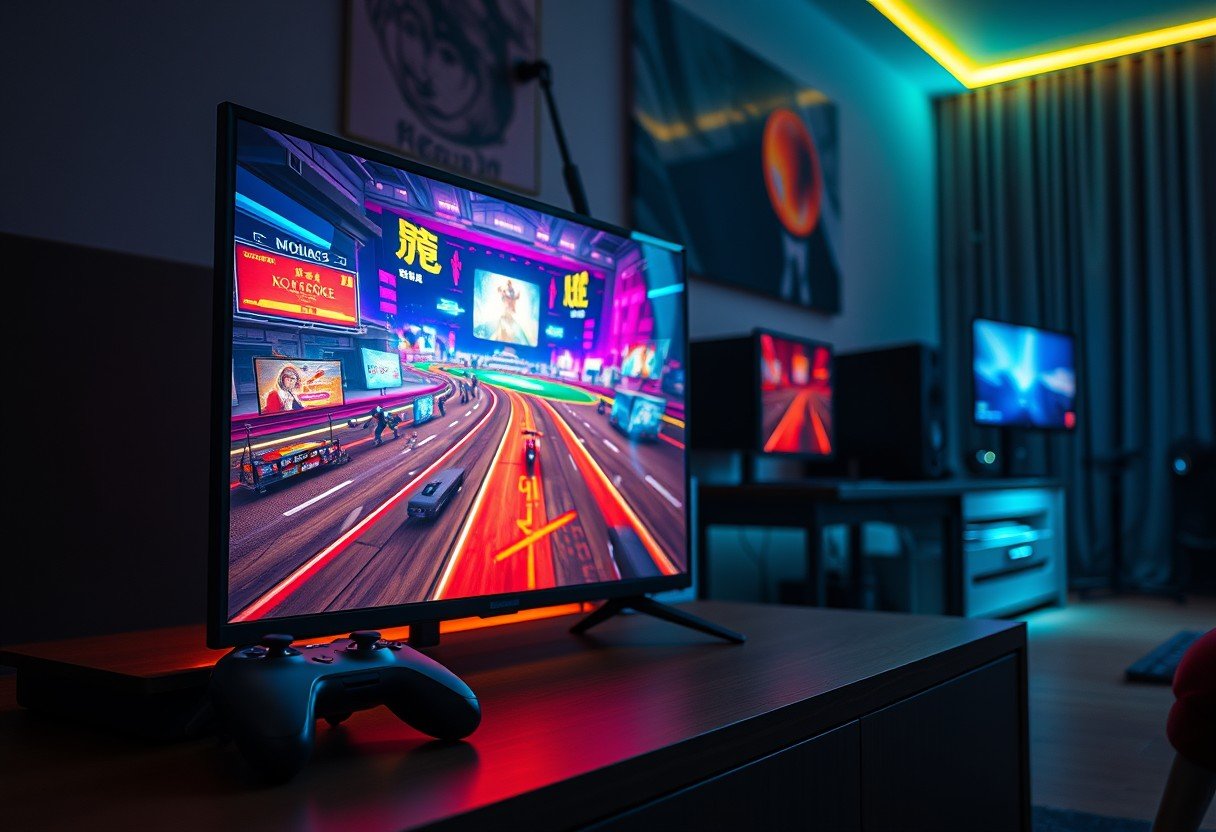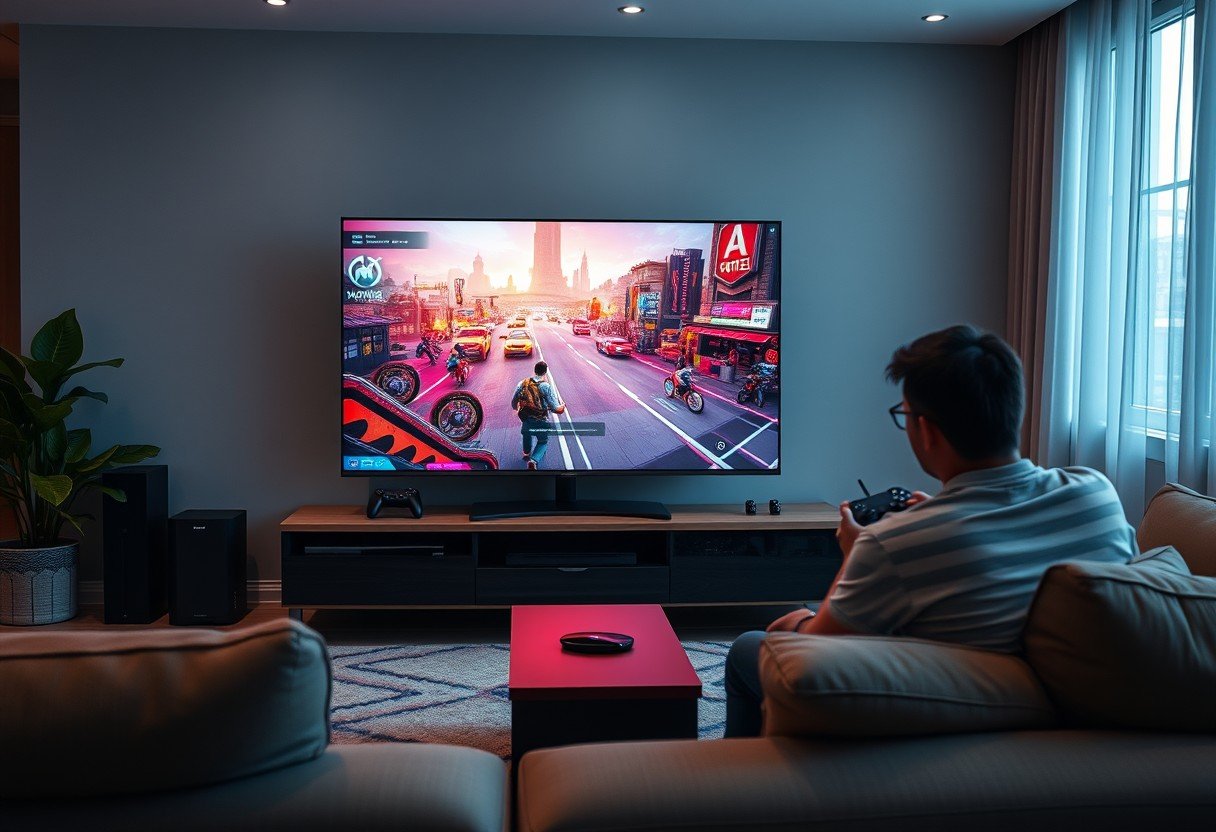Thinking about buying a curved TV for your gaming setup? You’re not alone. Many gamers wonder if the unique shape really improves the experience or if it’s just a gimmick. A curved TV aims to pull you into the game world by wrapping the screen around your vision, but it’s important to know the pros and cons. This guide will help you understand how they work, what benefits they offer, and what drawbacks you might face before you decide to invest.
What Exactly Makes a Curved TV Different?
Unlike the flat screens we are all used to, curved TVs have a screen that is slightly bent inwards. This concave shape is designed to match the natural curvature of the human eye. The main goal is to create a more panoramic and immersive viewing experience for you.
The idea is that by bringing the edges of the screen closer to your peripheral vision, the TV can make you feel more like you are inside the game or movie. This design intends to increase your sense of depth and make the whole picture feel more lifelike and engaging. It’s a technology built entirely around the concept of pulling the viewer deeper into the on-screen action.
This unique shape also affects how light interacts with the screen. For some, this can mean fewer distracting reflections, while for others, it can create new challenges depending on the lighting in the room.
The Big Advantages of Gaming on a Curved Screen
When it comes to gaming, immersion is everything. A curved TV is built to deliver exactly that. The screen’s curve wraps around your field of view, creating a sensation that you are part of the game world, not just looking at it from the outside. This enhanced depth perception can make expansive game worlds feel more vast and action sequences more intense.
Many people also find that curved TVs offer better viewing angles. The curve helps maintain color and contrast consistency even when you’re not sitting directly in the center. This can be a huge plus for local multiplayer games with friends.
Everyone gathered in the room can get a more uniform and high-quality view of the action. This makes curved TVs a compelling option for gamers who enjoy both solo adventures and group gaming sessions, as every player gets to be equally immersed.
Potential Downsides to Consider Before Buying
While the immersion is a major selling point, curved TVs aren’t perfect. One of the most common complaints is the potential for image distortion. If you are not sitting in the “sweet spot” directly in the center, the geometry of the image can look slightly warped or bent, especially at the edges.
This can be a problem for households where multiple people watch from different positions. What is immersive for one person might be distracting for another who is sitting off to the side.
Another issue is space and placement. The curved design means the TV will stick out more from the wall than a flat screen, which can be a problem for wall mounting or in smaller rooms. You also need to sit at a specific distance for the curve to be effective, which might not be possible in every living room or gaming den. Careful planning is required to make sure your room can accommodate a curved TV properly.
Finally, curved screens can sometimes handle reflections in a strange way. While they might reduce glare from a single light source, they can also catch light from wider angles and distort the reflections across a larger area of the screen, which can be distracting during gameplay.
Curved vs. Flat TVs: a Head-to-Head Comparison for Gamers
Deciding between a curved and a flat TV can be tough. Both have their own strengths, and the best choice often comes down to personal preference and your specific gaming setup. A flat TV offers a more traditional and predictable viewing experience that works well from any angle.
On the other hand, a curved TV provides a unique sense of depth and immersion that a flat screen can’t replicate, but it’s best enjoyed from a central position. The price is also a major factor; curved TVs have often been more expensive, though this gap has narrowed over time. However, the market has shifted, and today there are fewer curved models available as manufacturers focus more on advancing flat-screen technology like OLED and QLED.
To help you visualize the key differences, here is a simple comparison:
| Feature | Curved TVs | Flat TVs |
| Gaming Immersion | Enhanced, panoramic experience | Standard, traditional experience |
| Viewing Angle | Best from the center, consistent from sides | Consistent from all angles |
| Reflection Handling | Can reduce direct glare but may distort reflections | More prone to direct reflections |
| Price and Availability | Often a higher price, with fewer models available | Widely available at all price points |
How to Pick the Perfect Curved TV for Your Setup
If you’ve decided a curved TV is right for you, not just any model will do. To get the best gaming experience, you need to pay close attention to the specifications. These technical details are what separate a good TV from a great gaming TV.
A larger screen size generally makes the curve more effective and immersive, but make sure it fits your space comfortably. Beyond size, several key features will have a direct impact on your gameplay. Prioritizing a high refresh rate and low input lag is crucial for fast-paced and competitive games.
Here are the most important specs to look for:
- Resolution: Aim for 4K (3840 x 2160) for sharp, detailed visuals that bring game worlds to life.
- Refresh Rate: A minimum of 120Hz is essential for smooth motion and to avoid blurring during fast action scenes.
- Input Lag: Look for a TV with a low input lag (ideally under 20ms) to ensure your controller inputs are registered on screen almost instantly.
- HDR Support: High Dynamic Range (HDR) provides better contrast and a wider range of colors, making games look more vibrant and realistic.
- HDMI 2.1: This is a must-have for next-gen consoles like the PlayStation 5 and Xbox Series X, as it enables features like 4K gaming at 120Hz.
Models from brands like Samsung have historically been leaders in the curved TV market, often featuring their QLED technology for bright and colorful images. Checking reviews from trusted tech sites that specifically test gaming performance can help you find a model that excels in these areas.
What Do Other Gamers and Experts Say?
When curved TVs first hit the market, they were met with a lot of excitement. However, over time, opinions from both experts and everyday users have become more mixed. Many gamers who made the switch praise the immersive feeling, stating that it genuinely enhances single-player, story-driven games.
Industry reviews often highlight the impressive depth and cinematic quality that a curve can provide. Tech experts frequently analyze performance metrics like color accuracy and input lag, and while many curved models perform well, the curve itself is often cited as a feature that comes down to personal taste.
However, a significant number of users have pointed out the drawbacks. Some gamers report that the curve feels unnatural for games that involve a lot of straight lines or grid-based interfaces. Others find the reflection issue to be a deal-breaker depending on their room’s lighting. Ultimately, the consensus is that while a curved TV can be great for a solo gamer with the right setup, it’s not a universally superior choice for everyone.
Frequently Asked Questions about Curved TVs for Gaming
Is a curved TV better for certain game genres?
Yes, curved TVs tend to be best for first-person games like racing simulators, flight simulators, and first-person shooters. The wrap-around effect enhances immersion and peripheral awareness in these genres. They may feel less natural for 2D platformers or strategy games with flat maps.
Does screen size matter for a curved TV?
Absolutely. The benefits of the curve are much more noticeable on larger screens, typically 55 inches and above. On smaller screens, the curve is so subtle that it offers little to no immersive advantage over a flat screen.
Do curved TVs cause more eye strain than flat TVs?
Some studies suggest that because the curved screen mimics the natural shape of our eyes, it can actually reduce eye strain during long sessions. The entire screen remains at a more uniform distance from your eyes, which may lead to greater comfort.
Are curved TVs good for multiplayer gaming?
This is debatable. While the curve can help maintain image quality for viewers on the sides, the ideal viewing experience is from the center. Players sitting at sharp angles may notice some geometric distortion, making flat screens a safer bet for large multiplayer gatherings.
Why are there fewer curved TVs available to buy now?
The consumer market has largely favored flat-screen TVs. As a result, many major manufacturers have reduced their production of curved models to focus on improving flat-panel technologies like OLED, QLED, and Mini-LED, which have wider appeal.









Leave a Comment